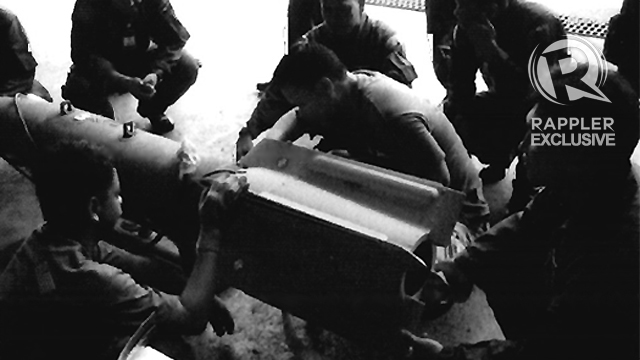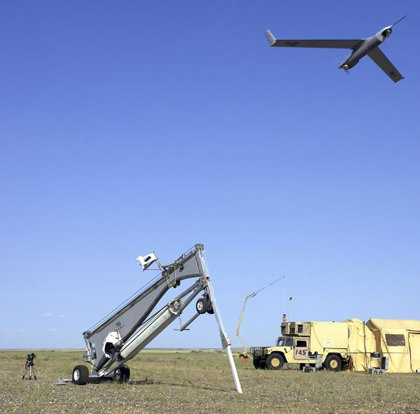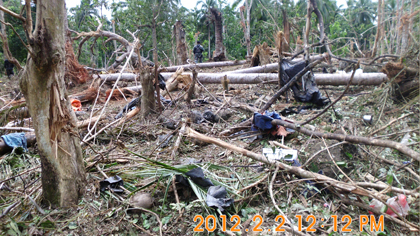SUMMARY
This is AI generated summarization, which may have errors. For context, always refer to the full article.

MANILA, Philippines – The Philippines’ first smart bomb attack on February 2 on Abu Sayyaf and Jemaah Islamiyah terrorists was the result of 15 months of training and technology transfer from the United States to Filipino forces.
The information below was gathered over more than a year from military officers and civilian intelligence sources in at least 3 different countries.

In the early morning hours of February 2, a Scan Eagle unmanned aerial vehicle (UAV) showed a joint team of US and Filipino soldiers a live feed of what was happening on the ground inside the camp of a senior Abu Sayyaf leader in Parang, Sulu.
They watched the thermal image of their “military asset” – a double agent – and compared what he was texting them with the images they were watching. The asset texted the location and pattern of movements of the people around him – information the soldiers verified through the thermal images they saw. When he texted that he was leaving the camp, the soldiers watched his thermal image walk away.
Scan eagles, also known as drones, have been operating in the Philippines for many years now.
Although originally flown from US navy ships and operated by civilian contractors, there are smaller drones operated by US special forces. Don’t mistake these for the Predator drones and Global Hawks carrying hell fire missiles that killed Al-Qaeda and other terrorist targets in Pakistan and Afghanistan.
In the Philippines, drones are used only for surveillance.
This was confirmed by Philippine President Benigno Aquino III on Tuesday largely because a drone strike handled by the Americans may violate the Philippine Constitution. US troops, Mr Aquino said, “are here as advisers. They are here as trainers. They cannot participate in combat operations.”
Which is exactly what they have been doing.
The US military arrived in the Philippines in February 2002, dubbed the second front in its “war against terrorism.” At its peak, US troops reached 1,200, including 660 US special forces.
The military alliance also includes technology transfer.
In mid-2010, Washington pledged $18.4 million of precision-guided missiles funded under a US Congressional Act, which allowed its defense department to train and equip foreign military allies.
A classified document from the Philippines is explicit: “Fiscal year 2010 assistance for the Philippines provides a precision-guided missile capability to assist Philippine Armed Forces’ counter-terrorism efforts in southern regions to combat the activities of the Jemaah Islamiyah and Abu Sayyaf Group.”
November arrival
The first smart bombs, PGMs or Precision-Guided Munitions kits, arrived in the Philippines on November 1, 2010.
According to a technical timeline obtained by Rappler, Philippine Air Force pilots sat down with subject matter experts to lay out a training plan in December.
Weapons training began the following year, on Jan 24, 2011.
Two months later, aircraft installation & training started, leading to test drops which were scheduled to begin in May of the same year.
On June 20, 2011, the US delivered at least 22 more PGM kits to the Philippine military.
During this period, US defense contractor Raytheon, the company which makes the PGMs, visited the Philippines 3 times, according to the documents.
Finally, on Feb 2, 2012, after nearly 8 months of training, the Philippines deployed its first smart bombs.
Target: JI in Sulu
The targets had long been under surveillance: the 2 most senior Jemaah Islamiyah or JI leaders in the Philippines sheltered by Abu Sayyaf leader Umbra Jumdail, better known as Doc Abu.
They are Malaysian Zulkifli bin Hir, better known as Marwan, who carried a $5-M reward on his head from the US government, and Singaporean Mohammed Abdullah Ali, known as Muawiyah, who had a $500,000 reward for his capture or death.
“There was a target that was of high enough value with actionable intelligence and the right conditions that would warrant its use,” said a military source privy to the operations. “These are expensive devices so they are used for the right targets at the right time.”
There was a long, involved process to get to this point, governed by protocols set by both nations, according to documents obtained by Rappler.
The Philippines and the US followed 2 levels of clearance and parallel approval processes.
First, ground commanders from both nations identify a target. For the Americans, its Joint-Special Operations Task Force-Philippines (JSOTF-P) then coordinates with the US Embassy before getting approval from SOCPAC, the Special Operations Command, Pacific in Hawaii.
After SOCPAC approves, it alerts the US Pacific Command (PACOM). Then it goes back to JSOTF-P which then notifies its Philippine counterpart of concurrence for the target.
On the Philippine side, the commander of the Joint Task Force Comet (Sulu’s military unit) coordinates with the Western Mindanao Command (WESTMINCOM) and when US concurrence happens, WESTMINCOM approves the target and authorizes execution by Filipino troops.

Between 2 and 3 am on February 2, Philippine Air Force OV-10 Broncos dropped the 227 kg (500 lb) bombs in the strike zone in a remote village in Parang, Sulu, demolishing much of the area.
In the dark
The first signal that new technology was used was the choice of when to drop the bombs.
In the past, planes could only drop their payload during daylight because pilots used visual cues.
Now the smart bombs can strike in the dark because they are guided by GPS or a homing device.
About 45 minutes after the bombing, the military asset texted his handlers that he would check “the targets.”
Sources said they watched a thermal image move back to the area. His text said that Doc Abu had been “obliterated.” Marwan was allegedly “cut in half from the waist,” while Muawiyah was barely breathing with blood gushing out of a deep neck wound.
Based on that, the Philippine military announced the deaths of these key leaders.
Wrong info
But it now appears that the asset was wrong about Marwan and Muawiyah.
Civilian and military intelligence reports from at least 3 countries show both JI leaders are still alive.
Last week, Malaysia’s chief counterterrorism official Ayob Khan Mydin Pitchay said Marwan was still alive.
Philippine military spokesman Col Arnulfo Marcelo Burgos maintained his position the JI leaders are dead and said Malaysia should provide “conclusive proof of life.”
On the use of smart bombs, there are conflicting responses from the Philippines.
Col. Burgos, based in Manila, said the military “neither confirms nor denies the existence of such munitions citing operational security reasons. However, its pilots have been training vigorously to further improve their proficiency particularly in the precise delivery of munitions to its identified target.”
Col Jose Cenabre, the head of Sulu’s Task Force Comet, categorically denied the use of smart bombs: “I strongly deny that. That’s just talk. We did not use them.”
However, Lt Col Miguel Ernesto Okol, spokesman of the Philippine Air Force, told Rappler: “Our pilots’ accuracy in the past was not good. They were not adept, but now with considerable time training and through the advice of our allies, particularly the US military, we are able to increase the accuracy of our pilots to 80 to 90%.” – with reports from David Santos/Rappler.com
Maria Ressa is the author of Seeds of Terror: An Eyewitness Account of Al-Qaeda’s Newest Center of Operations in Southeast Asia (Free Press, 2003). The information in this piece is part of the research for her upcoming book From Bin Laden to Facebook.
Add a comment
How does this make you feel?
There are no comments yet. Add your comment to start the conversation.